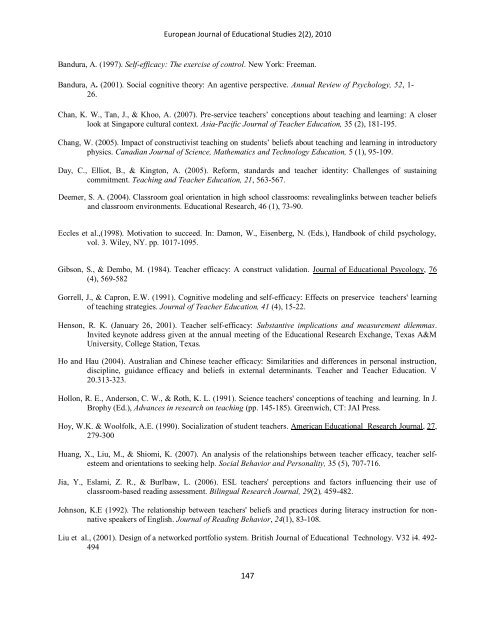European Journal of <strong>Educational</strong> Studies 2(2), 2010Question 9 (How much can you do to motivate students who show low interest in schoolwork) factor loading of0.448.Question 13 (How much can you do to get children to follow classroom rules) factor loading of 0.493.These three questions were on the perception of teachers on how to deal with disciplinary problems in the classroomin terms of being able to control difficult students, students who show low interest in school work and for students tofollow classroom rules. From the responses of these teachers, they failed to perceive these roles of the teacher asleading to effectiveness in the classroom.From the factor analysis of the teachers response to self-efficacy, teachers were able to rate themselves on how theyperceive their levels of professional effectiveness, and were also able to distinguish between the various aspects oftheir professional duties/ work in which they feel more and less effective. The teachers perceived that they were ableto create a good working relationship within and around the school, good atmosphere / morale for student learning,improving students learning outcomes, involving parents in their children’s learning, creating a positive schoolclimate, promoting good relationship / rapport between the school and students and soliciting for both material andpersonnel resources for effective learning outcomes. The teachers in this study had a strong self-efficacycompetence and professional qualities. However, in the area of getting through to the most difficult students,motivating students who show low interest in schoolwork and getting children to follow classroom rules, theteachers had a weak sense of their effectiveness. Gorrell and Capron, (1990), suggested that "it is important to instilla sense of efficacy in those who are being prepared to ensure that they have the confidence to attempt to apply theirknowledge when the appropriate time comes" (p. 15).This was also supported by (Dembo and Gibson, 1985)” theextent to which teachers believe they can affect student learning may influence teacher/student interactions andteachers' success in facilitating gains in student achievement”.RECOMMENDATIONSThis study should provide a new perspective on teacher educational quality in Botswana, with a view of improvingthe effectiveness of classroom teachers. There should always be teacher self-efficacy or teachers’ effectivenessresearch study more often to find out from the teachers, their own views/ perceptions on their effectiveness at theBotswana junior secondary schools. From the results of this study, it was observed that there were areas that theteachers’ perceptions were very weak due to low factor loadings, these areas should be investigated and looked intobecause it has implications on learning outcomes of students at the Botswana junior secondary schools, since mostof the teachers find these tasks very challenging. In areas of the low factor loadings on the self-efficacy scale fromthe responses of the teachers, teacher education in Botswana should provide more courses to train in-service teacherson how to handle difficult students, motivate students who show low interest in schoolwork and get children tofollow classroom rules. According to Eccles et al.,(1998) “ student with low academic interest can be motivatedwhen they find that the knowledge is useful, interesting and important, and that they have the ability to learn it”.Teacher preparation programs should consider integrating new curricula into their agenda that will facilitateteachers' acquisition of crucial self-regulatory learning strategies. Therefore, the present study sought to examineself-regulatory strategies that can inform new curricula.REFERENCESAshton, P. T. (1985). Motivation and the teacher's sense of efficacy. In C. Ames & R. Ames (Eds.), Research onmotivation in education, Vol. 2 (pp. 141-171). Orlando, FL: Academic Press.Ashton, P. T., & Webb, R. B. (1986) Making a difference: Teachers’ sense of efficacy and student achievement,New York, Longman.Bandura, A. (1986). Social foundations of thought and action: A social cognitive theory. Englewood Cliffs,NJ: Prentice Hall.Bandura, A. (Ed.) (1995). Self-efficacy in changing societies. New York: Cambridge University Press.146
European Journal of <strong>Educational</strong> Studies 2(2), 2010Bandura, A. (1997). Self-efficacy: The exercise of control. New York: Freeman.Bandura, A. (2001). Social cognitive theory: An agentive perspective. Annual Review of Psychology, 52, 1-26.Chan, K. W., Tan, J., & Khoo, A. (2007). Pre-service teachers’ conceptions about teaching and learning: A closerlook at Singapore cultural context. Asia-Pacific Journal of Teacher Education, 35 (2), 181-195.Chang, W. (2005). Impact of constructivist teaching on students’ beliefs about teaching and learning in introductoryphysics. Canadian Journal of Science, Mathematics and Technology Education, 5 (1), 95-109.Day, C., Elliot, B., & Kington, A. (2005). Reform, standards and teacher identity: Challenges of sustainingcommitment. Teaching and Teacher Education, 21, 563-567.Deemer, S. A. (2004). Classroom goal orientation in high school classrooms: revealinglinks between teacher beliefsand classroom environments. <strong>Educational</strong> Research, 46 (1), 73-90.Eccles et al.,(1998). Motivation to succeed. In: Damon, W., Eisenberg, N. (Eds.), Handbook of child psychology,vol. 3. Wiley, NY. pp. 1017-1095.Gibson, S., & Dembo, M. (1984). Teacher efficacy: A construct validation. Journal of <strong>Educational</strong> Psycology, 76(4), 569-582Gorrell, J., & Capron, E.W. (1991). Cognitive modeling and self-efficacy: Effects on preservice teachers' learningof teaching strategies. Journal of Teacher Education, 41 (4), 15-22.Henson, R. K. (January 26, 2001). Teacher self-efficacy: Substantive implications and measurement dilemmas.Invited keynote address given at the annual meeting of the <strong>Educational</strong> Research Exchange, Texas A&MUniversity, College Station, Texas.Ho and Hau (2004). Australian and Chinese teacher efficacy: Similarities and differences in personal instruction,discipline, guidance efficacy and beliefs in external determinants. Teacher and Teacher Education. V20.313-323.Hollon, R. E., Anderson, C. W., & Roth, K. L. (1991). Science teachers' conceptions of teaching and learning. In J.Brophy (Ed.), Advances in research on teaching (pp. 145-185). Greenwich, CT: JAI Press.Hoy, W.K. & Woolfolk, A.E. (1990). Socialization of student teachers. American <strong>Educational</strong> Research Journal, 27,279-300Huang, X., Liu, M., & Shiomi, K. (2007). An analysis of the relationships between teacher efficacy, teacher selfesteemand orientations to seeking help. Social Behavior and Personality, 35 (5), 707-716.Jia, Y., Eslami, Z. R., & Burlbaw, L. (2006). ESL teachers' perceptions and factors influencing their use ofclassroom-based reading assessment. Bilingual Research Journal, 29(2), 459-482.Johnson, K.E (1992). The relationship between teachers' beliefs and practices during literacy instruction for nonnativespeakers of English. Journal of Reading Behavior, 24(1), 83-108.Liu et al., (2001). Design of a networked portfolio system. British Journal of <strong>Educational</strong> Technology. V32 i4. 492-494147
















